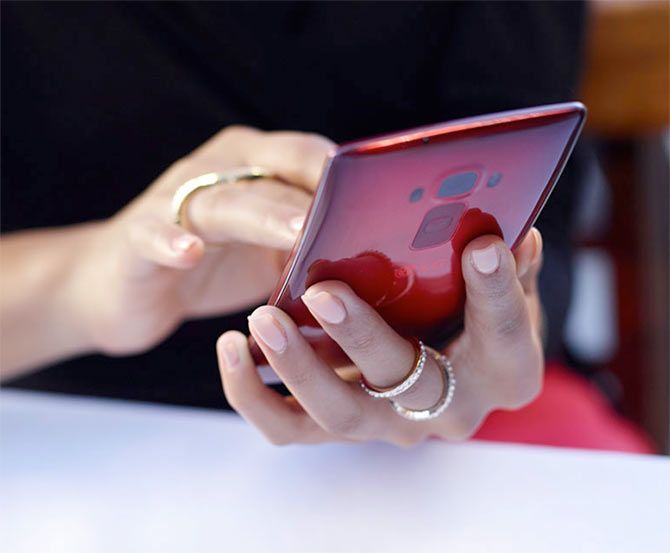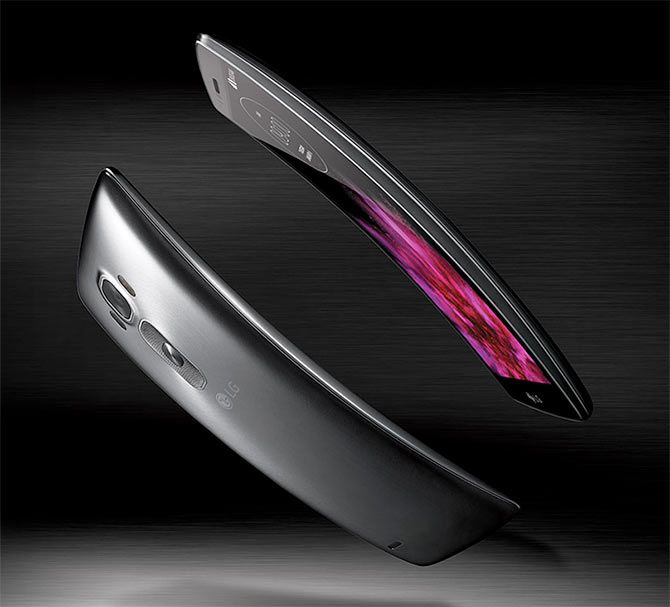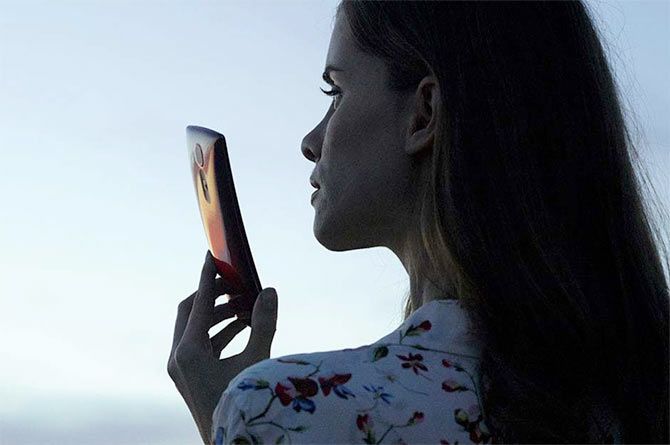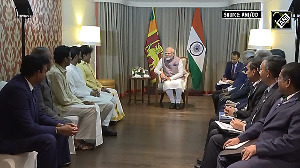Review of LG's latest premium phone

After creating the buzz with a curved phone, the LG G Flex, the company is ready with the phone's successor. According to LG, the phone will provide more immersive experience with the curved display, just like how the curved television sets do.
The phone seems to be LG's reply to Samsung's Galaxy S6 edge, to try something out of the box in times which has seen mobile phone market saturate with innovative ideas of late.
LG decided to upgrade the second coming of the curved phone substantially, and tried to take care of the blunders it committed earlier.
It is time to take a closer look at LG's premium phone.
Design
The designing of the mobile phone is indeed the unique selling point of the phone. LG has not only given a good thought in its attempt to present something unique, they have tried to iron out some previous anomalies as well.
The phone has got some actual and real flex to it. The LG head of smartphone planning, Dr Ram-Chan Woo at the unveiling event showed the G2's flexing capabilities by actually sitting on the phone. The device survived the ordeal without as much as a creak.
Given the trial by fire, one can confidently forget about the phone going out of shape or developing any cracks during normal usage.
LG has smartly gone with a P-OLED, that is plastic variant of the OLED (Organic Light Emitting Diode). The firm didn't stop here, as it provided the Gorilla Glass 3 and LG's own Dura Guard for the screen. This ensures overall protection.
The back panel is removable and has been rendered a spin hairline finish. The back buttons are really a hit or a miss with the users. Last but not the least, the speaker has been provided at the back, thus freeing the front or the sides of the phone.
Display

As mentioned already, the P-OLED being plastic based, the display is a sturdy and flexible unit while retaining the qualities of an OLED. That means the black levels are mighty impressive here among other benefits.
The screen is a 5.5-inch affair, with a resolution of 1080 x 1920 pixels. The pixel density is 403 ppi and makes the text and images look sharp.
The screen is very impressive. With excellent viewing angles, sharp images, and good contrast levels, there was really less to complain, and more to marvel about.
Hardware
The phone comes equipped with impressive innards. Inclusion of the powerful, yet overheating Snapdragon 810 octa-core processor might raise eyebrows. This phone happens to be the first one released in 2015 carrying the said processor.
The phone is packing the octa core processor in the form of four cortex A57 cores running at 2GHz, and another four ARM cortex A53 cores running at 1.5GHz. For the GPU, the phone is packing Adreno 430, and 2 GB of RAM completes the troika.
The phone comes with 16 GB of internal memory, which was good to see as a bare minimum. Users can increase the storage memory with the aid of a microSD card, and the phone supports a whopping 2 TB worth of memory cards.
The fact that a memory card of such capacity hasn't even been released is another matter.
Connectivity

Right at the start, the missing support for the 2300 Mhz band was utterly disappointing. For a flagship device, something which is banking on a novelty factor vis a vis its design a lot, missing out on one of the most preferred band for 4G in a country where 4G roll out is the talk of the town, was indeed very strange to say the least.
The phone comes with other connectivity options like Wi-Fi, Wi-Fi Direct, Bluetooth v4.1 (with aptX technology), Infrared, A-GPS, GLONASS and DLNA as well.
Software
The phone runs the Android 5.0 Lollipop, of course with LG's own user interface slapped on it. The operating system brings in some really nice features and keeps the bloatware to manageable levels, which was good to see.
The LG's skin exhibits traits of the material design, which is pretty much evident with the more flatter looks. People seeking the near pure android shouldn't get their hopes too high as that is not the case. At the first glance itself, there are some good features onboard which will provide some good user experience.
Dual Window: This feature has gained good amount of traction, and for good reasons too.
For a phone with substantial screen size, the luxury to execute two apps simultaneously isn't a far fetched idea. And Dual Window mode allows users to do exactly that. The feature was a pleasure to use and bodes well, but it has its quirks as well.
It doesn't support all the apps, and doesn't allow the ones running to be moved around about on the screen. LG needs to work on these aspects soon.
The Glance view: This is something which Motorola would have been proud of as well. The feature allows the users to take a look, or 'Glance', at the notifications which have arrived while the phone is in sleep mode itself. All it takes is a swipe from top of the phone.
KnockOn: This is a neat feature to wake up the screen of the phone. The user taps on the screen twice, and the need to use the power button is taken care of. Handy utility this one.
The Knock code: This feature is a fancy word for the user adjustable code for unlocking the phone.
LG's Wellness platform seems to be an ambitious project, where it not only collects data from tracking of distance, steps, calories etc, it also keeps data on user's sleep pattern as well, thereby allowing the user to build a better overall environment around.
It has its inaccuracies as well, but one can only hope that it gets better because it looks like a good concept.
Performance

For most part, the phone handles itself pretty well. There were no issues faced while playing the HD games or movie files with high bit rate. Sadly, this wasn't the case throughout.
The phone gets hot even without doing too much CPU-intensive task. The slim metal chassis is clearly having issues in dissipating heat. To compound the issue, with more heat generation, the CPU speeds gets throttled to prevent any damage to the chip and that results in a degraded user experience with the phone.
The transition effects, the animations, which included even the swiping away notifications started to show the lags and this was irritating. Once the temperature cooled off, things started to get back to normal, but the mood was well and truly off by then.
The bundled headphones do a good job doling out the sound, and thankfully too, as speaker at the back wasn't really up to the mark. The sound levels were low for the liking and the quality wasn't superior either.
Camera
The LG G Flex 2 features a 13 MP camera for the rear variant, which comes with a laser focus and dual LED flash. The front facing camera has been equipped with a 2 MP snapper.
As for the performance, the Flex 2 performs superbly during the day or during well lit conditions to be precise. The colours retain their accuracy, and there is an admirable level of details preserved in the pics. Users won't be complaining too much here, especially when they experience the laser focus swinging into action quickly and helping establish focus quickly.
When clicked indoors, the dual LED flash comes to the rescue and the pics again come out nicely, but some noise does creep in. The result still did not leave too much room for complaints.
The phone is capable of shooting 4k (UHD) video, but the duration for these have been clipped to a maximum of 5 minutes only. This right here is more or less proof of the shortcomings of the processor and its heating problems. The demanding UHD videos will generate good amount of heat, and heat up things inside the chassis.
Users can choose to shoot 1080 p videos, which came out to be impressive as well. But the curtailing of the 4k videos is something which shouldn't have happened.
One of the big advantages users will experience here will be the Optical Image Stabilisation, while the selfie fans will get to take advantage of the gesture based shots. LG also made sure that once the selfie has been clicked, simply lowering the screen next to the face will automatically bring up the preview mode too.
Battery
The phone comes with a non-removable 3000 mAh battery, which was a bit surprising since the predecessor of the Flex 2 had a greater capacity battery. Never the less, the phone still chugs all the way to near about two days worth of battery backup with this pack.
There is the Qualcomm's Quick Charge technology (ver 2.0) onboard as well, enabling the user to get the battery charged to 50 per cent in under 40 minutes, and the complete charge is attained within an hour itself.
There is also the power saving mode, which can be made to kick in at 15 per cent of battery life left. The user can also enable the mode right from the beginning itself.
Overall, the battery performance was pretty much satisfactory.
Verdict

The G Flex 2 is LG's take on innovation and what can be done in an increasingly design wise saturated scenario of the mobile phones. Sadly, the G Flex doesn't capture the mood the way others, for example, Samsung Galaxy S6 edge does.
The curved display according to LG is immersive, but that isn't the case. To the credit of the company, there are improvements from the first model, but with heating and stuttering issues it becomes really difficult to hardsell this novel design from LG. The inclusion of the controversial chipset always was risky, and surely the gamble hasn't paid off.
Retailing for a shade above Rs 50,000, this phone will only stand a chance if the owner intends to draw attention, or wants something to experiment with. Unless LG comes with a hefty price cut, it is not too difficult to suggest Samsung's Galaxy S6 Edge over this one.











 © 2025
© 2025